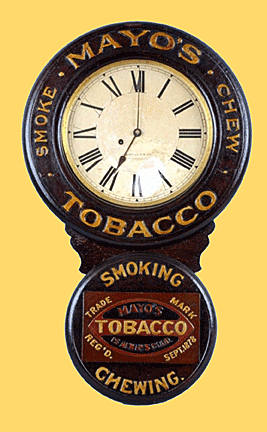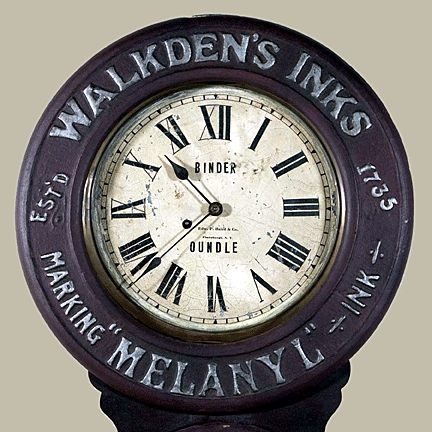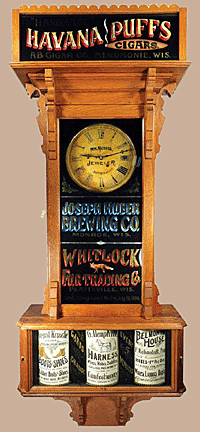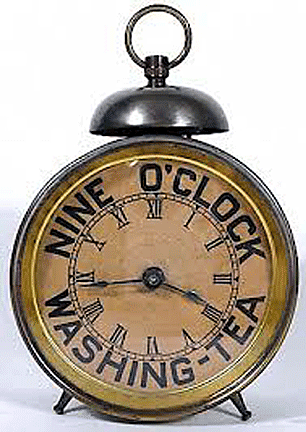|
Promoting Through Time
by Bob Brooke
 It’s
common to see a variety of items—coffee mugs, pens, glasses, and
such—with advertisements printed on them. But in the 1890s, a clock
advertising a company was a novelty. Clocks promoted foods and
beverages, household products, even medicines, such as Monells Teething
Cordial for Children. They even advertised pet food like Clarke’s Patent
Buffalo Meat Dog Cakes, endorsed by Queen Victoria, herself. Each clock
said something different on it. It’s
common to see a variety of items—coffee mugs, pens, glasses, and
such—with advertisements printed on them. But in the 1890s, a clock
advertising a company was a novelty. Clocks promoted foods and
beverages, household products, even medicines, such as Monells Teething
Cordial for Children. They even advertised pet food like Clarke’s Patent
Buffalo Meat Dog Cakes, endorsed by Queen Victoria, herself. Each clock
said something different on it.
Advertising clocks really came into their own during the late 1800s. One
of the first advertisements on a clock was Reed’s Tonic, an elixir that
would fix any ailment from malaria to indigestion. While the company is
no longer in business, the clock—made by Edward Baird—that “sold” the
advertising is still around.
Edward Payson Baird---Creator of the Advertising Clock
Born in Philadelphia in 1860, Edward Payson Baird went to work for the
Seth Thomas Clock Company in 1879. In 1887, he left Seth Thomas to form
his own company, the Baird Manufacturing Company, in Montreal, Canada,
to produce cases and doors for advertising clocks to house Seth Thomas
movements. While he made his cases of pine or oak, he used papier-maché
for the doors, with embossed letters around the clock face promoting the
virtues of one product or another. Baird had numerous clients in the
United States as well as in Canada and Great Britain.
 Baird
used papier-maché for his clock doors because of the ready availability
of wood pulp in Canada. By 1890, he moved his operation across the
border to Plattsburgh, New York. When economic circumstances forced him
to close his Plattsburgh factory in 1896, Baird shifted his base of
operations to Chicago, where he produced clocks with embossed, stamped
tin advertisements. However, by that time interest in advertising clocks
had begun to wane, so he concentrated his efforts on manufacturing parts
for the fledgling telephone industry. Baird
used papier-maché for his clock doors because of the ready availability
of wood pulp in Canada. By 1890, he moved his operation across the
border to Plattsburgh, New York. When economic circumstances forced him
to close his Plattsburgh factory in 1896, Baird shifted his base of
operations to Chicago, where he produced clocks with embossed, stamped
tin advertisements. However, by that time interest in advertising clocks
had begun to wane, so he concentrated his efforts on manufacturing parts
for the fledgling telephone industry.
While some advertising brands, like Coca-Cola, are instantly
recognizable and still exist today, many other products and brand names
have long since disappeared. Baird clocks are the only clocks made from
papier-maché that have advertising on them. Most resemble a figure 8.
For the most part the dial on these clocks measures 12 inches and the
hands are straight, with a few exceptions. All Baird clocks have two
doors unlike many other clocks produced at the time with only one door,
giving access to the dial and pendulum. The top doors are 18 inches
wide, while the bottom ones are 12 inches wide. While most Baird clocks
were 30½ inches long, Baird did make smaller 26-inch models.
A Baird clock has been compared to the look of a toilet seat, with the
top part holding the face, and the smaller door on the bottom containing
the mechanics with which to wind the clock. Both doors had printed or
embossed names of companies or products around the edges, and opened
with brass hinges. In the beginning, Baird painted his clocks brick red.
Later, he changed the color to a darker brown and eventually to
mahogany, On some the color changed with age.
 Seth
Thomas, the famous American clock maker, made the movements for the
Baird clocks until a year before the company folded, when Baird began
using movements from several other makers. His clocks were 8-day models,
which meant they were spring-loaded and needed to be wound once a week,
with a one-day grace period, giving people time to forget without losing
time. Seth
Thomas, the famous American clock maker, made the movements for the
Baird clocks until a year before the company folded, when Baird began
using movements from several other makers. His clocks were 8-day models,
which meant they were spring-loaded and needed to be wound once a week,
with a one-day grace period, giving people time to forget without losing
time.
Baird sold his clocks door-to-door, making them for the companies to
hang in shops or general stores. He printed the company name on the
clocks, and then those companies would give them away to businesses that
used their products.
For instance, razor blade companies would put Baird clocks with their
company name on them in barbershops and stores that sold razor blades.
Coca Cola would place their clocks in soda fountains, train stations and
markets.
Companies from all different categories bought these clocks, from
newspapers like the Commercial Gazette of Cincinnati, Toledo Blade,
Times of Philadelphia, and Bright and Newsie to businesses that were as
varied as Ghirardelli Chocolate and Dr. Pepper. One of the most valuable
Baird clocks to date is a Coca Cola advertising clock that sold for
$25,000.
Other Advertising Clocks
 There
are many different kinds of advertising clocks. One of the largest and
most unique is the Sydney Advertising Clock. Built in the 1880s, this
huge clock, stood 68 inches tall. It had reverse painting on the doors,
which was the first advertisement. The cabinet on the bottom of the
clock held three revolving cylinders, with four sides each, that carried
advertising cards inside. At each quarter or half turn of the clock, the
cards would rotate, showing a new ad for a different business each time.
This allowed the owner to sell multiple ad spaces on one clock. There
are many different kinds of advertising clocks. One of the largest and
most unique is the Sydney Advertising Clock. Built in the 1880s, this
huge clock, stood 68 inches tall. It had reverse painting on the doors,
which was the first advertisement. The cabinet on the bottom of the
clock held three revolving cylinders, with four sides each, that carried
advertising cards inside. At each quarter or half turn of the clock, the
cards would rotate, showing a new ad for a different business each time.
This allowed the owner to sell multiple ad spaces on one clock.
Although the company that made the clock gave it to businesses, it
charged a fee for the ads. On the dial, the name of the maker appeared
as free advertising. And for that the maker agreed to maintain the clock
in working condition for each year.
A “newer” advertising company was 9 O’clock Washing Tea, which hit the
markets around the turn of the 20th century. By using 9 O’clock Washing
Tea, women could have their laundry done and hung on the line by 9 am.
Tea was another word for soda or washing soda.
 Most
makers of advertising clocks constructed them cheaply. They used no
bezel or glass covering the dial, just laminated wood with a printed
advertisement and a simple time mechanism. Most
makers of advertising clocks constructed them cheaply. They used no
bezel or glass covering the dial, just laminated wood with a printed
advertisement and a simple time mechanism.
Back in the 19th and early 20th centuries, there was limited product
advertising. But consumers, especially in rural areas, spent lots of
time in the closest town’s general store, which made it the best place
to see product ads.
Unfortunately, the survival rate for advertising clocks is low. But to
the collector advertising clocks bring more bang for their buck because
of the history that comes with the advertisements.
A Baird clock in good working condition, with its original dial, glass,
movement, and paint job, can sell for around $3,000. Some exceptional
pieces sell for over twice that and higher. And well known brands, again
like Coca-Cola, can sell for even more.
< Back
to Collectibles Archives
Next Article > |
